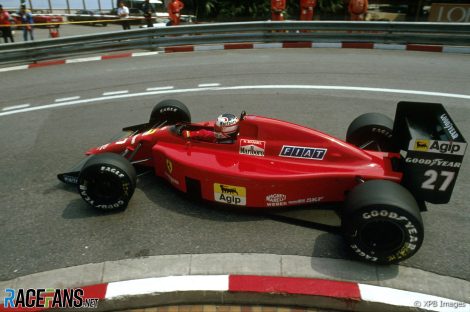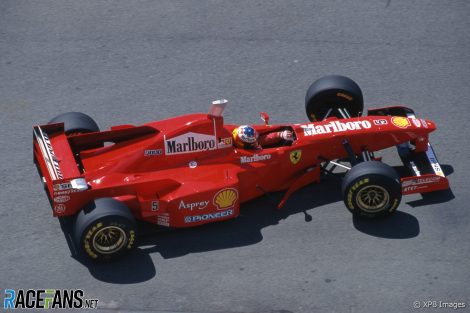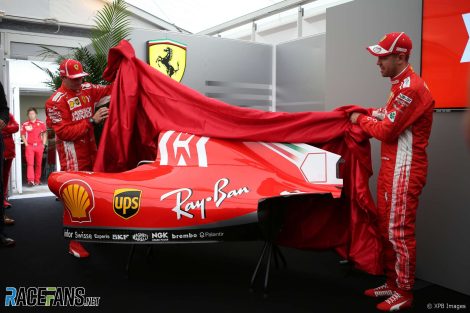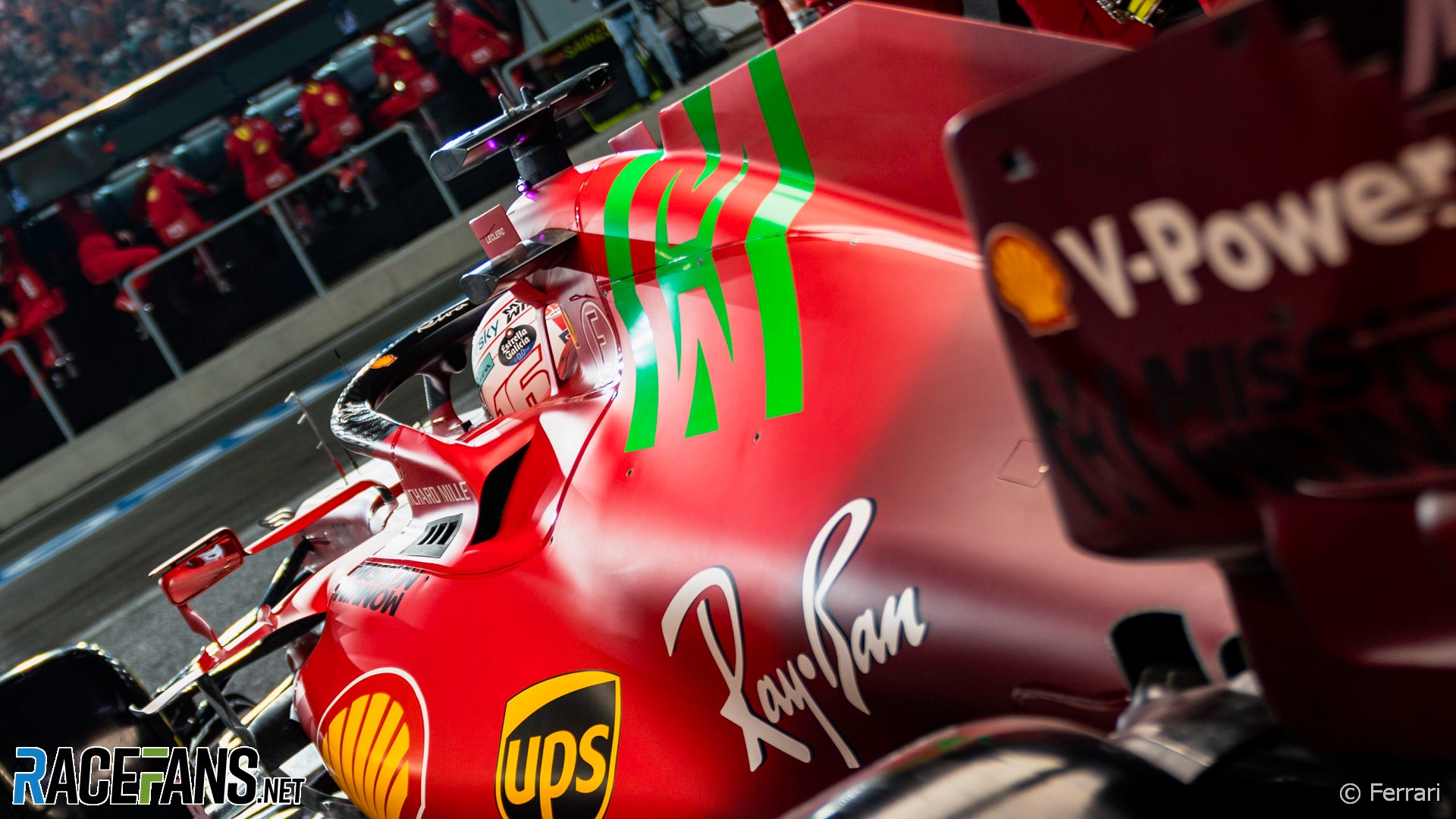In the aftermath of the Brazilian Grand Prix RaceFans directly asked Scuderia Ferrari CEO Mattia Binotto whether the team’s historic commercial and branding partnership with Philip Morris International (originally as Marlboro, now Mission Winnow), which expires this year, would be extended, and if so, under what terms and conditions.
“We are still discussing with PMI,” he said. “It is very likely PMI will remain, [but] maybe not as a title sponsor. So maybe, let’s see.“It can depend on what do you mean by Mission Winnow, on the car or not. You mentioned stickers, so we’re discussing [activation] rights. It will be announced as soon as we are ready to do it.”
Binotto’s words were immediately (mis)interpreted by outlets not present in the conference, who had ‘scraped’ the quotes. Hence suggestions of losses of up to $125 million in annual income for the team – in turn headlined along the lines of ‘Ferrari to lose historic Philip Morris sponsorship’ – which is most certainly not what Binotto said. Contrast such headlines with: “It will be announced as soon as we are ready to do it.”
Sources in the loop point to the deal being valued at $100m per year. Plus PMI has since 2011 used its Ferrari relationship as a business-to-business platform for key trade customers in hospitality and allied fields rather for direct consumer marketing purposes. ‘Mission Winnow’ is a corporate message rather than a product slogan; there are no reasons why such B2B benefits could not continue in future.

Commercial title sponsorship was introduced in 1968 in South Africa by Team Gunston – a local cigarette brand – and immediately copied by Gold Leaf Team Lotus, named after a British tobacco label. While various brands and product segments have exploited the opportunities offered by F1, the main beneficiaries have been tobacco products.
As the sector increasingly attracted the unwelcome glare of the global legislative spotlight it made commercial sense to link sponsor and team in the title to put the various brands before billions of eyeballs, but as tobacco bans bit so the prevalence of naming rights decreased. Ditto liquor and similar products, many of which have become regulated.
Advert | Become a RaceFans supporter and
The Ferrari-PMI relationship has progressively evolved over the past 30-odd years, having been formalised as title deal in 1997, although links between the two hark back to the early eighties, making it the oldest on the grid. It has achieved iconic status within both F1 and the wider sport.

Ferrari has long been aware that the partnership may well not be extended and surely made contingency plans to cater for such an eventuality. Anything less from a listed company would be a severe breach of fiduciary duty. Indeed, Ferrari’s cautionary statements regularly point to the inherent commercial risks of F1.
That said, the recent signing of Amazon subsidiary AWS points to the sponsorship wheels being in motion. Scuderia Ferrari AWS in 2022, anyone?
Overlooked in all the drama is that the budget cap means any reduction in sponsorship income will have little or no direct impact on performance. Before the cap’s introduction this year, teams’ annual budgets ran to close to $500m all-in – racing, marketing and hospitality and power units – of which around $300m was allocated to the racing operation.

All this points to Ferrari next year dropping ‘Mission Winnow’ as title partner – and possibly even reverting to a more traditional scarlet hue rather than racing under what has become known as ‘Marlboro Red’. Entering as ‘plain’ Scuderia Ferrari is even a possibility, but to suggest that Ferrari’s performance will suffer as a direct result is an assumption too far.
Advert | Become a RaceFans supporter and
News Focus
- F1 shows why NASCAR will struggle to recreate yesterday’s ‘Canada 2010’ drama
- How Hamilton and Ecclestone’s escalating feud prompted Massa’s new mission
- Red Bull celebrates its past at launch but Horner’s future remains the focus
- Why Andretti isn’t giving up yet on its attempt to enter F1
- Which races are vulnerable as F1 makes room for two Spanish rounds in 2026?





BasCB (@bascb)
23rd November 2021, 12:20
Scuderia Ferrari Prime would sound pretty nice.
Good background piece about what is going on with this deal Dieter!
AJ (@asleepatthewheel)
23rd November 2021, 12:57
Amazon Scuderia Ferrari?
Moe
23rd November 2021, 13:12
Lets just hope they change that GHASTLY green MW logo and that weird Burgundy fade in the back of the Ferrari. This year’s Ferrari was certainly the ugliest of the lot. Even the Haas looks cooler as a Russian flag.
Fantomius (@liko41)
23rd November 2021, 17:12
I kinda disagree.
Ferraris of Santander’s era were WAYYYY uglier
Johnny
24th November 2021, 13:31
The Haas is opposite from cool. That would fit better if it was Marussia or Russian Time or Hitech GP. I don’t want to say bad things about Brandon Seaber at all.
(BTW, he’s the guy who designed it)
Blakk
23rd November 2021, 13:41
Ferrari and Philip Morris are so closely tied on all levels of business activities, so I doubt that it will be end of it
ttongsul (@ccpbioweapon)
23rd November 2021, 13:45
what i hate about F1 is the this type of hypocrisy.
Cigarette advertising was banned years ago yet F1 teams always got a free pass to bypass it with subliminal marketing and corporate branding .
Alcohol sponsoring is banned but brands skirt this law by advertising 0% alcohol range and ” When You Drive, Never Drink” campaign which was also done to skirt alcohol ban as you see huge Heineken banners and poor cgi overlays on screen (cgi overlays are done for multiple reasons most notably so gambling adverts can be quickly ‘photoshopped’ out in markets where its banned for example) everywhere .
Phillip morris and Ferrari are allowed to spit in the face of fans with patronizing viral “Mission Winnow” 4d chess subliminal sponsoring
Same for McLaren who used silver west livery post ‘ban’.
silver branding was great multi tier value marketing from Ron Dennis who was a genius at marketing and maximizing the companies assets for maximum ROI, some examples are MP4- car designation does not mean Mclaren project actually it means “Marlboro project” , another was making a deal with west to have a grey packaging and matching livery so Mercedes, Mclaren and West brands had a cohesive linear easily recognizable branding and more importantly Ron get more sponsor cash from Daimler and Imperial Tobacco!!
This was made blatantly obvious when Mercedes went their own way in 2010 yet Mclaren still had silver for years after because they was still under Imperial Tobacco/Daimler branding contract
TL;DR
F1 is always been about money and I actually miss the cigarette and booze sponsoring as their funding allowed midfield teams to focus 100% on building fast cars and the opportunity to fight for wins such as Late 90’s Jordan with massive B&H money. Now we have bankrupt teams begging shady chinese companies for crumbs and megalomaniac billionaires like stroll and mazepin snr single-handedly funding teams and placing their spoilt sons in the seat…
ToneZone
23rd November 2021, 21:52
First of all, apologies as I accidentally reported your post when the page jumped suddenly as I went to reply.
Secondly, while I agree with your post, I’d like to add that F1 is no more hypocritical than governments who continue to cash in on tax revenues raised from tobacco companies. They won’t ban them outright because they’re addicted to the money.
Ciaran (@ciaran)
23rd November 2021, 14:01
The Philip Morris sponsorship is a “special” deal for a “special” team – both of which run the risk of appearing like archaic dinosaurs in a new world of sustainability, corporate social responsibility, etc.
PM’s concerns are more obvious – anti-smoking measures are the new norm and will only get more stringent. Ferrari’s are more interesting though, as their product has traditionally been loud, exciting, expensive cars… which is threatened by the trends of electrification and resentment towards excessive wealth. Very different worries, but they run the risk of furthering their antiquated image if they continue their partnership. I wouldn’t be surprised if they went their separate ways.
The glory days are likely over for both. In both business terms and visual appearance – that ghastly green MW logo is a far cry from the iconic 90s designs!
Neutralino
23rd November 2021, 15:33
Sales of luxury products, like Ferrari cars, are booming. With growing global inequality, it is Ferrari who stands to benefit. There may be worries for PMI about the future, but I believe that a Ferrari will always maintain its cachet and brand image.
Jere (@jerejj)
23rd November 2021, 15:44
I’ve never really cared about this whole thing. Entirely trivial for anything.
Uzair Syed (@ultimateuzair)
23rd November 2021, 16:14
I just want that horrible green logo to go away. And the boring matte red. And the ugly gradient.
I’d like Ferrari to bring back the 2007-08 livery. Or the 2018 livery. Those were nice.
Kringle
23rd November 2021, 16:15
Dribbling over that 310B picture, thanks!
Alan (@alan77)
23rd November 2021, 17:36
It would likely just change to one of PM’s vaping products.
Hiland (@flyingferrarim)
23rd November 2021, 17:42
Have to say that this was a very well written and researched write-up! Interesting read.
Simon
23rd November 2021, 23:52
Nope and nope…
SteveR
23rd November 2021, 19:01
But the current spending cap doesn’t include engine development, does it?
anon
23rd November 2021, 19:49
Dieter, with regards to the comment that “Commercial title sponsorship was introduced in 1968 in South Africa by Team Gunston” – would it not be more accurate to state that 1968 was the first time that a team chose to paint itself in a livery based on their sponsor’s colour scheme?
In 1960, British Racing Partnership, or BRP, renamed itself as “Yeoman Credit Racing” after their primary sponsor, Yeoman Credit Ltd., which is normally considered to be the first case of a team selling a title sponsorship deal. In 1961, when Yeoman Credit decided to start sponsoring Reg Parnell’s team, which was renamed as “Yeoman Credit Racing”, British Racing Partnership then proceeded to strike a sponsorship deal with the United Dominions Trust and renamed itself as UDT Laystall Racing Team, meaning that, by 1961, you already had two teams which had sold title sponsorship deals to third parties. Surely both of those significantly pre-date Team Gunston, to name just a couple of pre-1968 examples?
Dan G (@dang)
24th November 2021, 13:28
That’s really interesting.
I hope we never go to where cycling is, where professional teams are *only* named for their sponsors.
Spencer (@spencer)
23rd November 2021, 21:49
Also important to note is that for most of the long running PMI-Ferrari agreement, PMI owned all of the car’s space in terms of advertising. Essentially they bought the billboard and were allowed to resell the space to other advertisers.
Jay Menon (@jaymenon10)
24th November 2021, 11:54
@spencer
This is exactly what I was about to say.
PMI have calculated the cost vs benefits of being associated with Ferrari even if they dont necessarily have direct brand presence in the public view.
Does anyone know if the Ferrari-Marlboro packaging on cigarettes still persist in countries that have lax tobacco laws? i.e the Middle East? That association was pretty clear in the past. I remember buying a pack of Marlboros with an F1 car on it (no guesses for which one) at Sepang years ago. Its also curious that we have so many race in the Middle East how hey?
I’m quite surprised that PMI havent been flogging their smokeless products on the Ferrari. BAT appears to have gone all out with Mclaren. Velo and Vuse are very prominent on their cars.
bull mello (@bullmello)
24th November 2021, 17:41
At times Ferrari has had over twenty (about 25) MW logos from the cigarette company PMI. Including the garish green stuck on the red Ferrari. MW is everywhere with Ferrari on everything. Smoke ’em…
Get it over Ferrari, please.